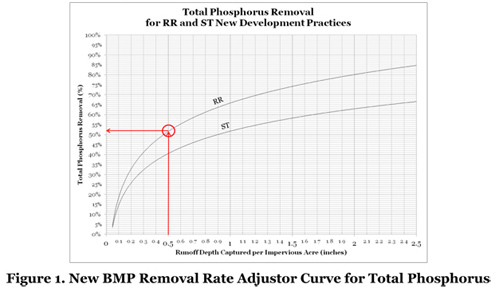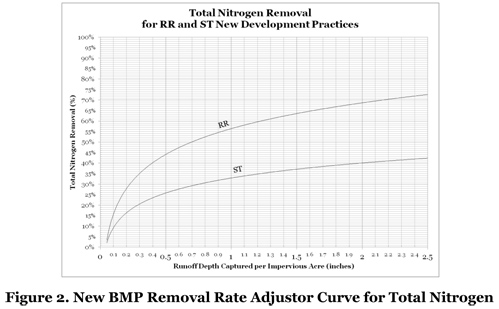
|
| Vol. 21, No. 1 |
January 29, 2013 |
|
|
Revised BMP Pollutant Removal Performance
Standards Approved
|
On October 9, 2012, the Chesapeake Bay Program Water Quality Goal Implementation Team approved revised BMP pollutant removal performance standards for eventual adoption into the Chesapeake Bay Total Maximum Daily Load (TMDL) Model. The standards, published in "Recommendations of the Expert Panel to Define Removal Rates for New State Stormwater Performance Standards", are based on Best Management Practice (BMP) load reduction recommendations from an expert panel that convened throughout 2012. The goal of the panel was "…to review all of the available science on the pollutant removal performance and runoff reduction capability of BMPs that are used to comply with the new state-wide performance standards for new development and redevelopment" for Chesapeake Bay TMDL tracking (Performance Standards, pg. 4). The panel developed a series of three graphs (Figures 1-3 below) to allow users to determine Total Phosphorus, Total Nitrogen and sediment percent removal rates based on the runoff depth captured per impervious acre. On each graph the user selects either "RR" (Runoff Reduction) or "ST" (Stormwater Treatment) based on a BMP classification found in the Performance Standards. For example, bioretention areas are classified as Runoff Reduction practices while wet ponds are classified as Stormwater Treatment practices in the Performance Standards. |
 |
 |
 |
One issue with the panel's recommended removal rates is that they do not match the BMP assessment and scenario builder tools that the Bay States are currently using to implement the Chesapeake Bay TMDL nor do they match the Virginia Department of Conservation and Recreation Stormwater BMP Clearinghouse removal rates used within the Commonwealth. "The Panel acknowledges that the new BMP removal rate protocol may require adjustments in the BMP assessment and scenario builder tools recently developed to assist states and localities to evaluate BMP options to develop watershed implementation plans…The CBPO [Chesapeake Bay Program Office] modeling team has expressed a willingness to incorporate the adjustor curves into the CAST [Chesapeake Assessment and Scenario Tool] modeling framework in the next year or so" (Performance Standards, pg. 14). Therefore, until these stormwater performance standards are incorporated into the Chesapeake Bay TMDL Model by the Chesapeake Bay Program, localities will have to continue to use the BMP assessment and scenario builder tools; the panel's recommended removal rates could however be used to assess future BMP implementation.
For more information, please contact Bethany Bezak. |
|
|
|
|
 |
|
|